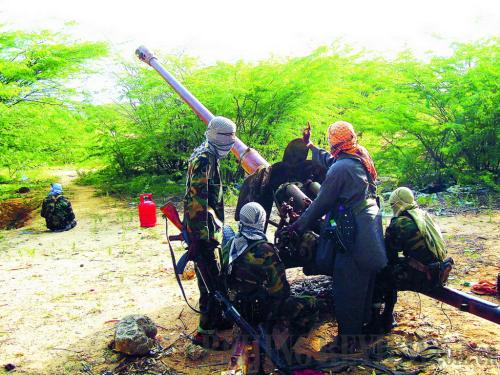|
 |
|
BIG GUNS: Armed conflict is a way of life in Somalia (XINHUA) |
Somalia is notorious for a handful of less admirable reasons than celebrating 50 years of independence this year. It is one of the world's prime examples of a failed state. Its dusty provinces (particularly those in the south) are tussled over by warlord militias, Islamic extremists, secessionist regimes and international peacekeeping forces alike.
Somalia's long coastline, bordering some of the busiest shipping lanes in the world across the Gulf of Aden, is plagued by roving bands of pirates that seek refuge on unpoliced Somali shores while hounded by international fleets protecting precious trade vessels and their cargoes. Southwards, along the same coast, the nominal capital, Mogadishu, is a small island of Somali sovereignty fiercely protected by a combined Africa Union (AU) peacekeeping force, propping up the fragile transitional government whose authority dimly extends over a small area surrounding the city. Geographically, Somalia's borders may seem distinct - but geo-politically, they are not.
Root causes
While many states in Africa face complex developmental challenges, few seem to have gone as hopelessly astray as Somalia. Where did it all go so wrong?
It is difficult to point out one particular moment in the region's long history that is particularly to blame, neither is one particular stakeholder in the long decaying state now, or historically, free of responsibility for its decline. Rather, Somalia has fallen afoul of a familiar sequence of problems that befell many other nascent African regimes over time- bad governance and mismanagement of scarce resources, and subsequent lackluster international attempts to intervene.
The British established a protectorate in Somalia in the late 1800s as the rest of the continent was likewise passed around the European powers. The Italians held onto the smaller northern region of Somaliland. Given the lack of any immediate resources to be extracted, the benefit of the area was strategic alone. This international strategic value only increased with the opening of the Suez Canal in the early 20th century and Britain's continued stake in the adjacent Middle East region, not to mention during the World War II when the horn of Africa became a strategic battleground between the Axis and Allied forces.
The 1960 independence government unified the two Somalilands, but what relative stability this brought was violently interrupted by a military coup in 1969, ushering in the long dictatorship of the Siad Barre regime. What benefits accrued to Somalis through the junta's initial extensive public works program and attempts at economic stability soon withered, as the weight of political oppression grew heavier. Soviet support for the Somali regime dwindled, so did their domestic legitimacy, and the military junta was itself dispensed with in 1990 by a coalition of political insurgent groups. As such, Somalia remained rudderless and in a state of civil war for over 15 years subsequent to the fall of that regime. None of the groups who had worked together to bring down the military junta had the authority or ability to maintain the whole region, and so authority was imposed locally in a deadly patchwork of warring, culturally and ethnically diverse power elites.
|